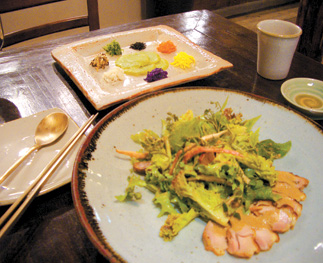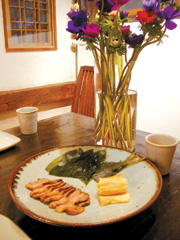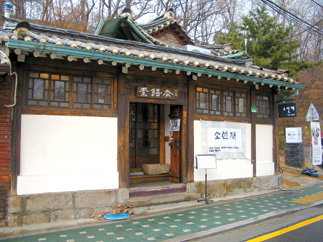Spring vegetables bloom at Soseonjae

salad with wild herbs and a Korean-style vegetable crepe. By Ines Cho
Thanks to fervent conservationists, recipes for classic Korean cooking are taught to aspiring chefs, yet Korean cuisine in general has lost its appeal and is facing a serious problem. There is a lack of the authentic ingredients that used to make Korean food so special. Vegetables that make up the Korean diet have been replaced with greenhouse varieties or imports from around the world.
Kim In-sook learned her cooking, naturally, from her mother who knew how to turn a bundle of spinach into a mouth-smacking namul. She grew frustrated when wild vegetables began to disappear from markets. Instead of buying vegetables that tasted like paper, to prepare meals, she went out to the mountains near Gwangneung, north of Seoul where she and her husband live. And she made her own sauces using the traditional fermentation method. Relatives and friends who tried her food were impressed. This was the beginning of a new career for Ms. Kim, who opened a Korean restaurant, Soseonjae, in Samcheong-dong in northern Seoul last year.
Soseonjae, which means a “humble banchan house,” is a cozy place with only eight tables in a remodeled hanok near the Blue House. A seven-course meal for vegetarians or non-vegetarian starts at 15,000 won (about $17) plus 10 percent VAT, but I went for the more elaborate 10-course meal named after a Korean king’s table. At 38,000 won, the sura full-course meal offers some of the most unusual and rare samplers from nature, tweaked by Ms. Kim’s personal passion for things authentic and natural.

Boiled pork with fermented vegetables By Ines Cho
Porridge, made with various fruits and vegetables ― such as dates, pumpkin or wild potato ― is classic, simple and clean, but dishes like Korean-style crepes called gujeolpan, featuring purple radicchio, grilled scallop or vegetable balls, not only deviated from authentic Korean cooking but also tasted like the chef tried too hard to impress.
But Ms. Kim’s effort is not wasted at Soseonjae. Her boiled pork served with classic jangkimchi and wild garlic leaves is worth a grand prize. She boils the pork neck in a vatful of broth made with scrap wild vegetables and roots for 30 minutes. The meat is sliced and matched with cabbage kimchi fermented with soy sauce and wild garlic leaves, also fermented in vegetable sauce. No spice, no garlic, no pepper. Just meat and leaves, but this unusual combination can impress those who appreciate the taste of substantial food that’s also good for you.
To accompany the tender meat, Mr. Cho recommended sogokju, home-made rice wine, served in a beautiful ceramic bottle (10,000 won). The wine originated in Hansan, South Chungcheong province and drinking it dates back to the Baekje Kingdom (BC 18-660), according to Mr. Cho.
The light brown wine served in a matching ceramic cup at first tasted strange because of the distinctive taste of grain malt (similar to Japanese sake), but the more I drank, the sweeter and more wholesome the wine became, melting bites of pork wrapped in salty-bitter vegetables. The taste skips the typical shock to the palate that low-quality Korean food imparts. Bursting with flavor yet perfectly harmonized in the mouth, the dish would have made a learned Korean scholar want to bring his wife and ask her to make it again for him at home.
The course meal ended with a set of steamed rice and doenjang-jjigae, or soybean paste stew, made with a paste that aged for 12 years.
To help his wife’s cooking, Mr. Cho compares the use of herbs in Western and Korean kitchens by studying “Kitchen Garden,” a book with a lot of illustrations.

The exterior of Soseonjae
“I get this stuff for her to cook,” Mr. Cho said.
Soseonjae
English: spoken, on the menu
Tel: (02) 730-7002
Hours: 11:30 a.m. to 9 p.m. daily
Location: along the road to Samcheong Park
Dress code: smart casual
Parking: nearby street parking
By Ines cho Staff Writer [inescho@joongang.co.kr]










with the Korea JoongAng Daily
To write comments, please log in to one of the accounts.
Standards Board Policy (0/250자)